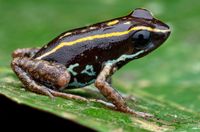Photos and their Story
The average size of a jumping-spider is around 6 mm. This is quite small, and to visualize this you can see here an adult male "Phintelloides versicolor" sitting on the pinky of my left hand. Usually I don't touch my subjects for several reasons, with the most important one that I don't want to harm these tiny creatures. I often use mosquito-repellant in the field what would do no good for spiders as well. In this case here, the little goblin hopped onto my hand right after I had left a restaurant outside of Chiangrai in Thailand where I had lunch. So with clean hands I couldn't resist to take this shot for size reference.
This is a tiny ant-mimicking jumping-spider hiding in the stem of a leaf at the Chiang Dao Wildlife Sanctuary in Thailand. Mimicry is wide spread in the animal kingdom and shows in a vast variety of forms. I have observed dozens of different spider species that are mimicking ants. And they do this for good reason. Many predators such as birds, lizards or amphibians avoid preying on ants due to their pugnacious behavior, painful bite and bad, acidic taste. To raise their deceiving game to the top, these spiders also lift their first pair of legs in to the air to make them look like the antenna of an ant.
This is a poison frog of the species "Phyllobates lugubris", which means something like "gloomy leaf climber". The often used general term "poison dart frog" is somewhat misleading, as only three very specific species are toxic enough to impregnate blowpipe arrows with their poisonous secretions for hunting.
These frogs do not produce the poison themselves, they ingest it with their food like ants and beetles and store it in their body, in order to secrete it via glands on their backs in case of danger. In order to be able to photograph these beautiful animals, I climbed a stream outside of Cahuita in Costa Rica at night with my guide Chris and the young biologist Mathieu, where Mathieu played an audio-file of the calls of this species with his smartphone to provoke a response from any other individual present. As the photo proves, this has been achieved.
This photo was taken by my friend Chatchawan (Eid) at the Phutthamonthon Park in Nakhon Pathom in Thailand. I take all my photos in-situ of free living wild animals except stated otherwise.
This is the photo of a female jumping-spider of the species "Hyllus diardi" that was taken at that same moment. With a body length of up to over 20 mm this species belong to the largest jumping-spiders worldwide. As most of my pictures this is a "focus stacked" image.




